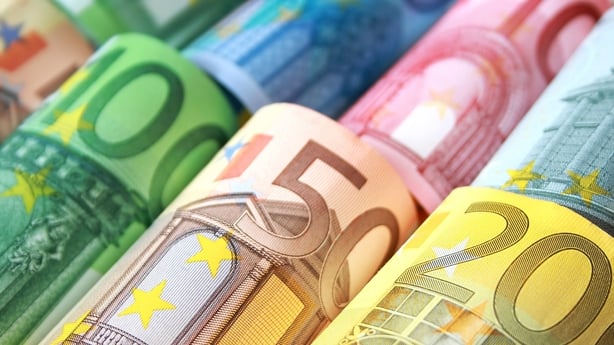Clock is ticking on enhanced deposit rate offerings

It’s typically known as the silly season – a period that extends throughout much of August where one topic or individual is at risk of getting sucked into a vacuum created by a dearth of regular news activity.
Last year, the banks found themselves at the centre of that vortex, as public and political pressure was piled on lenders to pass on a greater proportion of ECB rate hikes to depositors.
And they responded with a slight improvement in the rates that they offer, mainly on so-called term accounts where an individual is required to put their money aside for a period of time in order to get the full benefit of the rate on offer.
Remarkably few savers have availed of the opportunity so far, opting mostly to leave their money in easy-to-access accounts that continue to offer scant returns.
But time could be running out for depositors to fully benefit from the enhanced rate offerings. If the European Central Bank opts to cut rates – as expected – in the months ahead, will the banks respond by slashing the returns they offer on deposits?
If they are forced to pass rate cuts on to borrowers, a cut to deposit rates can likely be taken as a given.
Banks making a killing
Households have in excess of €150 billion collectively on deposit in Irish banks and other institutions.
We have one of the highest savings rates in Europe, which peaked during the pandemic, but has fallen back to more normal levels since.
It’s remarkable that we don’t appear to have been put off by the relatively low rates on offer on deposits here.
Indeed, that in itself may partly explain why banks don’t offer terribly attractive rates. They don’t really feel the need to entice us into putting money on deposit.
In fact, the banks and credit unions are crammed with deposits to the extent that the credit unions placed restrictions on the level of deposits that they would take from individual depositors during the era of negative interest rates as it was costing them to put excess customer deposits into the banks.
That situation has changed, however. Banks can now place their excess cash – that which they haven’t farmed out in loans or put aside for reserves – on deposit with the ECB at a rate of 4%, contributing to very healthy interest income in the banks’ annual reports.
So, are we all getting higher returns on our money now?
In short, no.
Despite the fairly short-lived furore about deposits last summer, savers don’t appear to have responded in great numbers to the decision by the banks to relent to public and political pressure and raise interest rates on certain deposit accounts.
Savers have to be proactive and seek out the accounts that offer the best returns. Higher rates do not automatically apply to the deposit account that their money is sitting in.
According to a study by price comparison website bonkers.ie towards the end of last year, about 92% of household deposits here were sitting in low yielding accounts bearing interest of on average 0.12%, which is then subject to DIRT (deposit interest tax) of 33%.
Both the Central Bank and the main retail banks themselves say they have detected a notable shift by depositors into the higher yielding accounts in recent months, but we’re still looking at a situation where about nine euro in every ten in deposits are not really making any return.
By leaving money in the demand accounts, savers are collectively leaving billions of euro on the table in interest that they could have been earning.
On top of that, the recent inflationary surge has effectively wiped a good portion of the purchasing power of that money away.

Should the banks be forced to extend higher rates to more accounts?
They could, but effectively mortgage holders would end up paying the price.
The banks, after all, didn’t pass the full extent of the ECB rate hikes on to borrowers.
Apart from tracker mortgage holders, who automatically get hit with each rate hike, the banks passed about half of the 4.5 percentage point increases on to their other mortgage products.
If they are forced to pass on more of the increase to depositors, mortgage holders would likely take the hit.
Robert Whelan, Managing Director of Rockwell Financial points out that the banks have plenty of scope to increase deposit rates while still making healthy margins.
He said it must be viewed in the context of the overall figures.
The banks lent out about €14 billion in mortgages last year, but excess deposits are hugely in excess of that amount, leaving clear profit for the banks on money that they lodge with the ECB.
“The banks are patting themselves on the back saying they’re keeping mortgage rates artificially low, and you have to give them credit for that,” he said.
“But the only reason they’re able to do that is that they’re making so much coin on the other side.”
He described the banks’ response to the pressure last year to give better returns on deposits as ‘modest’ and believes they could have done more to make people aware of the enhanced offers available on deposits.
“They could have written to customers with a balance of over €50,000 and said you have your money in this account, but we have this other account and maybe you should be looking at that.”
“They do write to people regularly, telling them of the loans and credit cards that they can offer them, but they don’t write to tell them about this fantastic deal on deposits,” he points out.
Can the money be put to work more effectively elsewhere?
Indeed, it can. There are numerous savings and investment platforms offering the full ECB 4% deposit rate on money and it’s paid out weekly or monthly.
The money is also usually accessible on demand.
German bank N26 has recently started offering 4% on savings to its top tier account holders. (However, this account carries monthly fees of around €17, which must be accounted for when calculating returns). Its other accounts offer rates of 2.8%. Importantly, deposits up to €100,000 are covered by the German Deposit Guarantee Scheme.
Trade Republic similarly offers 4% on amounts of up to €50,000, also with the deposit guarantee protection.
Dutch bank Bunq is paying out 2.46% on Irish users’ savings.
Lightyear, the online investment platform backed by Virgin founder Richard Branson, offers 3.25% on uninvested cash in its accounts.
It recently said the amount of cash held in Irish users’ accounts was growing at the fastest rate in the euro zone, which it attributed to the poor rates of return from the banks here.
Raisin.com is another option which offer access to savings accounts from across Europe with terms up to 3 years.

Currently, it is offering one-year fixed rates of up 3.5% and 3% on a demand deposit account, all with deposit guarantees applied in the country of account origin.
To be fair, there are some decent offerings within the Irish market too, although there is a bit more devil in the detail.
AIB has an online regular saver account which offers 3% on monthly savings of up to €1,000. The money is accessible on demand but the 3% rate reverts to a 0.25% offering after the first year.
PTSB offers 2.5% on a regular saver account with a maximum monthly deposit of €1,000. Once the balance in the account goes over €50,000, the interest rate on the whole balance also moves to a much lower variable rate.
Mark Coan, founder of moneysherpa.ie, recommends that individuals should aim to have 6 months of income in an instant savings account as an emergency, rainy day fund.
Some of the instant access accounts now pay interest on that money.
The remainder, he says, should be put aside in higher yielding products for longer to ensure even higher returns.
This is where the term accounts come into play with varying rates on offer.
As well as the banks, there are the state savings schemes which offer rates on money over up to ten years, and the returns are free from the deposit tax, DIRT.
So, what will happen to those rates if the ECB cuts its deposit rate?
While speculation is focusing on June for a first rate cut in years from the ECB, the chances of a surprise reduction in April are being talked up, especially in light of the unexpected rate cut from the Swiss Central Bank this week.
As many of the online accounts offer rates that are in line with the ECB deposit rate, as soon as it falls, the offers will likely reduce in synch.
The banks are less likely to act hastily by dropping deposit rates as soon as the ECB cuts, but they could scale back their offerings by the end of the year if the ECB has cut multiple times.
“If I was managing the publicity for an Irish bank, I’d say just hit pause for a few months,” Robert Whelan said.
The markets are pricing in three – and possibly four – cuts by the bank this year, which would bring the deposit rate back down to 3.25% or even 3%.
That would shave quite a portion off the bumper profits that Irish banks have been reporting.
“They will ultimately move them [deposit rates] down. If the rate they’re getting on the overnight rate drops, that’s going to have to be reflected in the rate that they’re giving their savers,” Mr Whelan added.
For those with excess cash beyond their emergency stash, they will have to move quickly to avail of the enhanced offers on term accounts.
Once the account is established, the banks have to honour the rate they have committed to at the time.
But given that the rates on offer at the moment from Irish institutions are not hectic, that situation will only disimprove as the ECB rate comes down.
The only thing that will likely change that is competition.
While more people are availing of the European offerings through the likes of Raisin, on the whole we tend to gravitate towards institutions and brands that have a presence in our towns and cities.
At the moment, there are just three main banks and the credit union housing the bulk of our deposits.
Until an established player comes into the market here, competition for deposits will remain muted, and with it, the returns we are offered.





